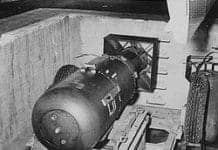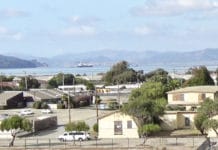by Carol Harvey
Why did the little dump truck run away?
Sometime on Monday, May 19, 2014, a car chase commenced on Treasure Island, San Francisco. Well, technically speaking, it was a truck chase.

About three weeks later, June 5, the San Francisco Boys and Girls Club formally announced permanent departure from the island. Three more weeks passed, and on Wednesday, June 25, during a toxin remediation meeting, a Navy official described talks with a club official about the club’s anticipated return.
Now, back to our chase.
The evading vehicle was actually a Volvo truck hired by CBI, an environmental remediation company. Apparently, the driver was instructed to cart toxic dirt from one site and dump it into another.
“Well,” you ask (and rightly), “that would be OK, wouldn’t it? Taking toxic dirt from one place and dumping it in another toxic dumpsite? That sounds perfectly legal, doesn’t it?”
Not exactly.
What you, a rational person, may not know is that the Navy has repeatedly announced throughout 2014 that the second site is in the process of being cleaned of all contaminants. So, dumping more toxic dirt into it would defeat the purpose. It would return the clean, safe site to its former dirty and dangerous condition.
Speculation is that the driver of the truck and his CBI bosses who sent him meant him to dump the chemical-rich dirt in secret.
Three people driving by in a car happened upon the truck leaving the toxic yard. Wondering where he was hauling the dirty dirt, they gave chase. One occupant videoed the truck from inside the car.
In the course of his drive, seven or eight blocks from where they picked up the Volvo truck, its driver apparently realized he was being tailed.
When the truck reached the purportedly cleaned-up site, he drove through an open gate into the yard. A female passenger got out of the car. Through the unlocked gate in the chain link fence, she used her cell phone to shoot video of the truck inside the yard.
Her footage showed the truck stopping briefly beside another small vehicle. There was a pause while the driver talked to a man near the vehicle. The truck did not dump the dirt. Instead, it turned around and drove back out the gate passing the waiting car to which the woman had returned.
“He looked at me and saw me videoing,” she noted with disgust. “Now, he’s running away.”
Ambling slowly after the truck, the car followed it around several blocks. After some turns, they arrived on the other side of the same dump site. This time, the truck halted at a locked gate.
Shortly, the gate opened. The truck disappeared inside and made a hard right. It slid behind a tarp-covered fence which barely concealed its shadowy form.
The cell phone camera caught the image of the back of the truck bed raising and lowering. Clearly, the contaminated soil was being dumped out of the truck onto the ground. Several days later, a slightly reduced pile sat in the spot where the truck had dumped it.
The first video is the raw footage recorded on May 19 and the second video explains the first.
What do we know?
Stripping speculation away, here is what we know.
A truck took dirt from a known toxic dumpsite and drove it to another dumpsite widely publicized as in the process of being cleaned of hazardous chemicals. Another vehicle tailed it. When the truck reached the second site, it drove inside. It stopped briefly. After appearing to confer with a man, the truck proceeded out of the yard without dumping its load.
The truck drove about eight blocks in a rectangular pattern to the other side of the same yard. It was shadowed by the car. Entering a gate, the truck passed behind a tarpaulin covering the chain link fence. Partly concealed from view by the filmy green tarp, it dumped its load of known toxic dirt onto the site. A passenger in the car used a cell phone to video the trip.
What is the significance of this chase?
The truck picked up a load of dirt from a storage yard, a known toxic dump. CBI – Chicago Bridge and Iron – is an enormous corporation that the Environmental Protection Agency (EPA) and the U.S. Navy often contract to remediate environmentally impacted sites. (Ignore the enormous conflict of interest glaring back at us.)

Gilbane is a smaller remediation company, somewhat like its larger and bigger brother fish. Both companies work often enough on Treasure Island to have a satellite operation permanently located there. (Also ignore the question raised by my sagacious editor: Aren’t the employees worried about toxic exposure themselves?)
Envirostor, a website of the California Department of Toxic Substances Control that lists toxic sites, shows the former Treasure Island Naval Station storage yard where the truck picked up its load to have been long “impacted” by a series of chemical poisons, all cancer-causing. Chief among them are TPHs, TCEs and PCEs, which remained on Treasure Island when fuel oil degraded after the Navy deposited it there.
TPH, Total Petroleum Hydrocarbon, is a broad family of types of chemical compounds found in ship and jet fuels – like benzene, toluene, xylenes, naphthalene, fluorine, and other petroleum and gas products. TPHs cause headache and dizziness and the nerve disorder, peripheral neuropathy – foot and leg numbness.
Animal studies show TPHs “can cause effects on the blood, immune system, lungs, skin and eyes” and on “reproduction and the developing fetus.”
“The International Agency for Research on Cancer (IARC) has determined that one TPH compound (benzene) is carcinogenic to humans.” That means benzene exposure can cause cancer.
The truck carted known carcinogenic soil from a former storage yard, an unclean site, to Site 31, where Navy contractors have nearly finished topping off deep water and bullrush-filled pits out of which they supposedly pulled additional cancer-causing chemicals.
Site 31, another toxic dumpsite
Envirostor shows the Navy “impacted” Site 31 with DIO, lead and PAHs, to name just a few. These are the virulent chemicals the Navy stated publicly it was cleaning from the site. You should very much fear exposure to these chemicals – especially constant exposure.
PAHs, Polycyclic Aromatic Hydrocarbons, are released by fossil fuel combustion. They can cause inheritable “malignancies and genetic damage in humans. …
“(H)eavy occupational exposure to mixtures of PAHs entails a substantial risk of lung, skin or bladder cancer.”
Why the little truck became an ostrich with its head in toxic sand: Escape of the Boys and Girls Club
Site 31, a former Navy storage yard and trash dump, had been paved over for an elementary school playground next to which the Boys and Girls Club of San Francisco maintained a facility.
After 13 years serving Treasure Island youth, in 2012, the Boys and Girls Club, without fanfare, shuttered their facility. Island residents guessed the reason for this very wise move. Several children who attended the elementary school nearby fell ill with toxin-related diseases.
Ironically, a multi-language “No smoking” sign remains displayed on the clubhouse windows – while lead, DDT, PCBs, diesel oil and dioxins lurk poisonously beneath the track and playground.
What the Navy doesn’t know
For several months, Keith Forman, the U.S. Navy’s toxic cleanup director, during Treasure Island RAB (Resident Advisory Board) meetings, has publicly announced he’s been in discussions with Maxine Wilson, vice president of operations for the Boys and Girls Club, regarding its two-year Treasure Island hiatus. On June 25, 2014, Mr. Forman stated that Ms. Wilson was encouraged that the Navy planned to restore Avenue E, the main employee access to the club building. Avenue E’s concrete pavement was broken in two segments so that the Navy could clean the deadly soil beneath.
Curiously enough, shortly after June 5, Site 12 residents received by snail mail an announcement from Boys and Girls Club President Rob Connolly in follow-up to Connolly’s June 5, 2012, meeting on Treasure Island with parents. (See “Sidebar: Boys and Girls Club announces permanent closure of Treasure Island Clubhouse” below.) Connolly stated, compassionately and with deep respect, that, due to dangers posed by environmental toxins near the Boys and Girls Club building, the club was permanently closing the building and would not return to the island.
Phantom return of the Boys and Girls Club
Robb Connolly’s letter dated June 5 raises the question: Why was Keith Forman talking as of June 25, 2014, nearly three weeks later, about the Club’s possible return. The event in which he spoke was an open meeting at which his staff covered the progress of the U.S. Navy’s radioactive and chemical contaminant remediation on former naval base Treasure Island?
It is inconceivable that, long before meeting with parents, the Boys and Girls Club did not inform island authorities TIDA (Treasure Island Development Authority) and the Navy about its permanent departure.
Or was the Navy, as it has been known to do in the past, once again concealing facts from the public?
Why was a dump truck contracted by CBI, a remediation specialty corporation based on the island, spotted and videoed removing radioactive and chemically contaminated soil from one known toxic site, then transporting and dumping it on a site being “cleaned”?
What inspired the driver of the truck carrying toxic dirt to evade a tracking vehicle by futilely driving behind a transparent tarpaulin – and, like an ostrich hiding its head in the sand, dump his virulent load?
Confusing dates raise serious questions
The Girls and Boys Club departure is sobering for island parents. It establishes that a venerable organization refuses to participate in exposing young people – their children – to radioactive and chemical poisons it knows to a certainty exist at its former site.

On May 19, 2014, two weeks before the official June 5 Boys and Girls Club pullout date, a truck dumped contaminated soil from a known toxic storage yard onto Site 31 near the clubhouse. Can one surmise that the Navy was fast-tracking a sloppy cleanup?
Were Navy contractors told – as has been suspected at Hunters Point Shipyard in the recent past – to cut corners with dirty dirt the “cleaning” of toxic Site 31 in a failed attempt to entice the Boys and Girls Club back to Treasure Island, thereby placing vulnerable children at future serious risk?
Is Keith Forman’s public June 25 disclosure three weeks following Boy and Girls Club President Robb Connolly’s June 5 withdrawal that Forman spoke with the club’s operations chief, Maxine Wilson, about reconnecting Avenue E for employee access a deception intended to confuse the public and control an embarrassing situation in which the first large island organization removed children from clear and present environmental dangers the Navy left during its botched cleanup? What if Job Corps and the other small island businesses employing many young people followed suit?
True remediation
Observing a protracted pattern of demonstrable truth-twisting, perhaps it is time for Treasure Island families to demand TIDA and the Navy fully remunerate them for illnesses and deaths from exposure to environmental poisons that they and their children, since 1999, have endured. Perhaps it is time for this group of 2,000-plus victims to insist on placement in equivalent or superior off-island housing and full repayment of back rent taken from them under conditions of apparent fraud.
Sidebar: Boys and Girls Club announces permanent closure of Treasure Island Clubhouse
In letters addressed to “Dear Parents and Members of The Treasure Island Clubhouse,” a section titled “Was Safety a Factor?” read:
“I am writing with the unfortunate news the Boys and Girls Club of San Francisco has decided to permanently close its clubhouse on Treasure Island as I announced in the community meeting on June 5th.
“As you likely know, since May 2012, we had dealt with remediation of hazardous materials in the soil on Site 31 just steps away from the clubhouse. When remediation began, we expected the work to be completed in just six months. We hoped and expected that Avenue E would re-open, Site 31 would be paved over, and that we could get back to the work we were doing with the youth. Two years later, remediation of Site 31 remains incomplete, and Avenue E remains closed.
“Unfortunately, we believe that the environmental concerns on Treasure Island will continue to exist for some time to come, creating at the very least a notable distraction from executing our program and fulfilling our mission, and, more importantly, concern for the safety and wellbeing of our staff and the children we serve.

“But, while the environment is the primary reason for our decision to leave, a lack of certainty about our future on the island once development begins and our concerns for the rapidly aging building we occupy makes restarting our program and hiring new staff even more challenging.”
A second notice sent to island residents, also dated June 5, 2014, titled “Treasure Island Clubhouse Closure,” underscored the club’s departure and offered answers to “Frequently Asked Questions:
“Since May 2012, we have dealt with the remediation of hazardous materials in the soil at Site 31, steps away from the clubhouse. Two years later, the remediation of Site 31 remains incomplete. Unfortunately, we believe that the environmental concerns on Treasure Island will continue for some time to come, creating a notable distraction from executing our program and fulfilling our mission.
“But, while the environmental issue is the primary reason for our decision to leave, a lack of certainty about the future of the island and our concerns for the rapidly aging building we occupy, makes restoring our program for hiring staff very difficult.
“We did engage with TIDA (Treasure Island Development Authority) on a few occasions to find an alternative location on the island but were never able to work out an agreement that worked for both organizations.
“Is this a permanent decision?
“Yes, this is a permanent decision. We have held on for a long time, hoping that the environmental concerns would lessen and that we would have a more positive outlook for what a clubhouse on the island would look like, and how our organization fits into the future development of the island. We continued until the end of May 2014 to incur operating costs of the clubhouse, paid for with our own funds. To run a high quality program on the island, we need much more stability than has existed on the island in the last two years.
“What was the decision-making point?
“We did not reach this decision casually or quickly. Our Board of Governors, President and senior staff workers worked closely together over the past two years to monitor, assess and debate the right course of action. Senior staff attended numerous TIDA and the community meetings, closely following the news, spoke routinely with the Navy and TIDA staff and held meetings with several senior City officials. We also held several meetings with our parents so they understood the concerns and our decision-making points.”
A final paragraph assured residents the decision was lovingly and carefully made:
“Please know that, while we tried to approach this decision rationally, our affection for our families and the community make it an emotional decision, too. We are saddened that we will no longer be part of the Treasure Island community, as we have thoroughly enjoyed our experience serving so many youth and their families during our 13 years on the island. We are grateful for the partnership with TIHDI, the funding from TIDA and the strong collaborations with our service providers. We are extremely proud of the contributions we have made to the community since June of 2000.”
The letters were signed by Boys and Girls Club President Robb Connolly and Vice President of Operations Maxine Wilson. Her assistant verified the Boys and Girls Club as the source of the letters, but Ms. Wilson herself could not be reached for comment.
Carol Harvey is a San Francisco political journalist specializing in human rights and civil rights. She can be reached at carolharvey1111@gmail.com.

 Store
Store












